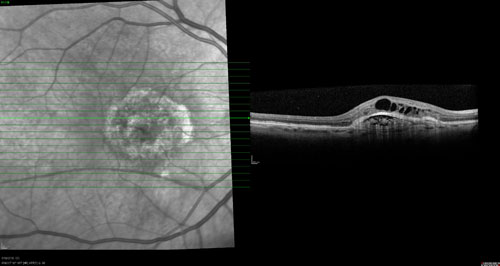
 |
Macular Degeneration |
 |

Macular Degeneration | ||
Wet Age-Related Macular Degeneration Dry Age-Related Macular Degeneration |
||
| ||
This disease is associated with aging. There are two forms. In the early stages of age related macular degeneration a breakdown of the cells in and behind the macula occurs, this is commonly referred to Dry Age-Related Macular Degeneration. As the disease progresses new abnormal blood vessels may begin to grow. Due to the fragile form of these new abnormal blood vessels they will often leak blood and fluid under the macula, this results in the second form; Wet Age-Related Macular Degeneration. | ||
| ||
The most common early symptoms may include blurred central vision, loss of detail when looking at objects or reading, or a growing dark spot in the central part of your vision. As the disease progresses you may experience distorted vision. | ||
| ||
Both forms of Age-Related Macular Degeneration may be evaluated by the use of special photography known as a fluorescein agiogram and optical coherence tomography, both tests are very important in diagnosing this disease. | ||
| ||
At this time there is no cure for wet age-related macular degeneration but there are successful treatment options available. The most common treatment is a painless injection of medication which is intended to absorb any leakage. | ||
| ||
Strong evidence has shown that as you are not able to change your genes or the fact that you age, a diet rich in fruits and dark green leafy vegetables may help to lower the risk of developing age-related macular degeneration. Along with diet; protective eyewear should be worn when in the sunlight. Regular eye exams can detect age-related macular degeneration early in the process and prevent progression. | ||
| ||
 |
 |
|
